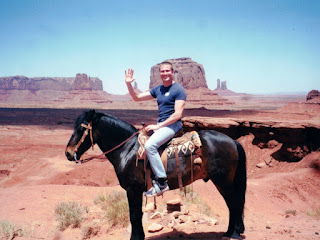My first ground visit occurred in July 2000. At the time, I was on my way to Text 100's San Francisco office for a two-week General Manager’s secondment. I flew into LA on Friday 28 July, passed through immigration and transferred mid-morning onto a flight to Las Vegas.
I spent three days exploring Sin City, including a spectacular helicopter flight that took me into the Grand Canyon at Grand Canyon West. The day trip involved two separate activities. The first was a breathtaking flight from Henderson Airport over the Hoover Dam, Lake Mead and the Grand Canyon, concluding with a landing 3,200 feet below the rim.
We landed on a sloping plateau, about 30 metres above the canyon floor, with an uninterrupted view of the Colorado River below. Our group of four, excluding the pilot, spent about 20 minutes on the ground toasting our visit with a glass of bubbles.
I’ll never forget the moment we flew over the canyon rim. The sensation of the ground suddenly falling away into a vast abyss will stay with me for the rest of my life. An American couple flying with me made the moment all the more memorable. As we passed the rim, the wife let out a classic melodramatic “wow” followed by more gasps and groans in a distinctly American drawl. Her breathless enthusiasm was rather infectious.
The tour included a video of our flight. When you play it back, this woman's delirious commentary can be heard in the background. Decades later it still makes me chuckle. I've arranged for the VHS tape to be converted to MPEG4. I'll try to upload a reel soon.
Perhaps the most astonishing aspect of this video was its creation. The pilot controlled two cameras as we flew, skilfully cutting from one to the other as the scenery unfolded below. Then, when our tour was done, he opened a hatch at the helicopter’s rear revealing a bank of video recorders. The company had set these up to simultaneously record our flight. The pilot ejected a tape from each machine and gave a copy to each of us. It's hard not to be impressed by such an efficient set-up.
From the canyon floor, we flew to Guano Point on the West Rim. Here members of the local Hualapai Indian tribe took us on a walk to view the canyon from ground level. Along the way, our local guide shared stories of the tribe’s history in the area and explained the magnificent geography unfolding before us. Of course, a ubiquitous display of handcrafts was also on offer.
In the years since the Hualapai have expanded their simple tourism venture to include an impressive glass floor Skywalk platform. This lets you walk out past the rim and experience the same “ground falling away” sensation I enjoyed on my helicopter flight.
Most of the tourism images you see of the Grand Canyon are taken from the south rim. The canyon is 731 meters deep at this point and spans more than 10km to the northern rim. I can confidently confirm that the vista is every bit as awe-inspiring as those postcards and posters promise. Although, like a typical antipodean traveller, I was equally enamoured by the squirrels running rampant around the lookout’s stunning vantage points.
We then returned to the airport and took a second flight to Goulding's-Monument Valley-Oljato Regional Airport. Landing here marked my first visit to Utah as much of Monument Valley’s famous landscape straddles the Arizona state border. This remote little airport can be seen in the image above.
Monument Valley isn't a valley in the conventional sense, but rather, a flat and desolate landscape surrounded by crumbling rock formations that rise hundreds of metres into the air. They're the last remnants of a sandstone layer that once covered the region, eroded by hot dry winds that howl through the desert.
It also provided the backdrop for one of Forrest Gump’s more memorable scenes. Do you recall the scene where Forrest Gump runs across the country? After gaining a large group of followers he decides it is time to stop. This pivotal moment in the movie was shot on Highway 163 in Monument Valley. The Forest Gump viewpoint has become so renowned that Google Maps now marks its location a few kilometres north of the state border.
At John Ford Point, a Navajo local kindly rode his horse onto an outcrop overlooking the valley below. As you see above, this allowed us tourists to capture an iconic Lone Ranger moment. Then, for a healthy tip, he let us sit on his horse for another memorable photo opportunity. Naturally, I was inspired to capture my own cliche moment for immortality.
The tour finished with a return flight to Grand Canyon National Park Airport where I transferred onto a tiny Cessna Caravan. This aircraft normally seats nine passengers. However, for reasons unbeknown to me, the pilot flew a weight-restricted flight back to Las Vegas. As a result, there were only four of us on board. I was even weighed before take-off.
I vividly recall buying a souvenir shirt and some sort of knick-knack at the airport, then witnessing an airline staff member's crestfallen face as I returned to the gate with my goodies. Thanks to my shopping spree this staff member was unceremoniously offloaded from the flight.
Then, as we prepared to take off, the pilot kindly warned us that the afternoon flights are often rather bumpy. As he explained, the sun’s unrelenting heat generates increasingly turbulent updrafts as the day progresses. He wasn’t wrong. More than once our tiny aircraft was bounced around in clear air as we passed over the Colorado River’s ancient rifts and gullies.






















No comments:
Post a Comment